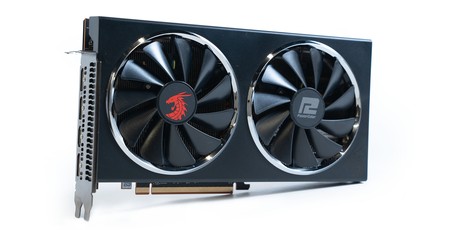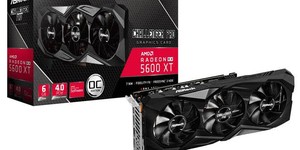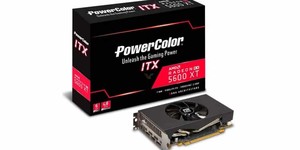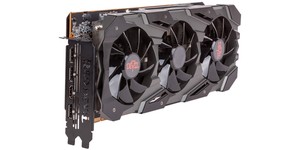
Announced at CES and released a few weeks later, the RX 5600 XT is AMD’s newest desktop GPU. Priced to tempt customers away from Nvidia offerings in the high-volume mid-range market and designed to be the ‘ultimate’ 1080p graphics card, it’s easy to see why it exists. However, it’s fair to say AMD’s launch “strategy” tarnished the introduction and potentially the long-term life of the product. In this review, we’ll give a recap on the product itself and why that is before assessing how this PowerColor model stacks up now that we’re two months into its life cycle and the market has settled – potentially for longer than anyone foresaw.
As its name suggests, the RX 5600 XT plugs the gap between the RX 5500 XT and RX 5700. Unless it wanted to undertake the expensive process of designing and making a new GPU, AMD had the option of either producing a souped-up variant of the Navi 14 GPU in the RX 5500 XT or a cut-down version of the Navi 10 GPU that powers the RX 5700 Series. It opted for the latter, and here’s how that looks in a specs table:
| AMD Radeon RX 5700 XT | AMD Radeon RX 5700 | AMD Radeon RX 5600 XT | AMD Radeon RX 5500 XT | |
|---|---|---|---|---|
| Architecture | RDNA | RDNA | RDNA | RDNA |
| Codename | Navi 10 | Navi 10 | Navi 10 | Navi 14 |
| Base GPU Clock | 1,605MHz | 1,465MHz | 1,130MHz | 1,607MHz |
| Game GPU Clock | 1,755MHz | 1,625MHz | 1,375MHz | 1,717MHz |
| Boost GPU Clock | 1,905MHz | 1,725MHz | 1,560MHz | 1,845MHz |
| Compute Units | 40 | 36 | 36 | 22 |
| Stream Processors | 2,560 | 2,304 | 2,304 | 1,408 |
| Texture Units | 160 | 144 | 144 | 88 |
| ROPs | 64 | 64 | 64 | 32 |
| L2 Cache | 4MB | 4MB | 3MB | 2MB |
| Transistors | 10.3 billion | 10.3 billion | 10.3 billion | 6.4 billion |
| Die Size | 251mm2 | 251mm2 | 251mm2 | 158mm2 |
| Process Node | 7nm | 7nm | 7nm | 7nm |
| Memory | 8GB GDDR6 | 8GB GDDR6 | 6GB GDDR6 | 4GB or 8GB GDDR6 |
| Memory Data Rate | 14Gbps | 14Gbps | 12Gbps | 14Gbps |
| Memory Interface | 256-bit | 256-bit | 192-bit | 128-bit |
| Memory Bandwidth | 448GB/s | 448GB/s | 288GB/s | 224GB/s |
| Board Power | 225W | 185W | 150W | 130W |
Even before launch, then, it was clear the RX 5600 XT would be closer to the RX 5700 than to the RX 5500 XT. After all, it has the same 36 Compute Unit count as the RX 5700 and even includes the full 64 ROPs. AMD does actually produce a 32 CU Navi 10 part, the Radeon RX 5600 (OEM only, hence its exclusion above), but it focussed instead on lowering clock speeds to differentiate the RX 5600 XT from the RX 5700. This also allows AMD to run the card with a Total Board Power figure of 150W, a saving of 30W.
The other key difference, of course, is the memory – both bandwidth and capacity. First up, AMD has dropped from four 64-bit memory controllers to three (which also costs it 1MB of L2 cache), and this is an instant 25 percent loss in bandwidth. Even more is lost by the card having 12Gbps memory instead of the usual 14Gbps. In the end, it still has significantly more memory bandwidth that RX 5500 XT, but 288GB/s is 36 percent less than the 448GB/s enjoyed by the card above.
The 192-bit interface also plays into the use of a 6GB frame buffer, as it’s usually best to pair each controller with the same amount of memory (2GB per controller). 192-bit/6GB has long been a combination Nvidia is comfortable with, but it’s rarely seen from AMD, which tends to stick to 4GB or 8GB (or both). 6GB could start to become uncomfortable territory as the impact of the upcoming new consoles spurs on more detailed game worlds that require more memory – the Xbox Series X and PS5 are confirmed as having 16GB of GDDR6, though not all of that will be available to their custom GPUs. The 6GB figure also looks bad considering 8GB variants of the RX 5500 XT are readily available, but it should at the very least help with retaining competitive pricing.
As we reported, the run-up to the RX 5600 XT’s launch is where things went awry. It began with Nvidia cutting the price of the RTX 2060 from $349 to $299 in anticipation of the impact AMD’s $279 card would have. Seemingly unable or unwilling to reduce the launch price in response, AMD stuck to its $279 guns and suggested to its partners that they push certain OC SKUs further with a VBIOS update to increase their performance by altering the GPU frequency curve, the power limit, and – most crucially – the memory data rate. Partners were now free to set memory speeds of 14Gbps instead of 12Gbps – a 17 percent increase in memory bandwidth. AMD didn’t change the reference specifications, however; its focus was on the OC SKUs, many of which were already in the hands of reviewers for launch-day performance results and reviews.
Changing OC SKU guidelines is fine and no doubt part of the back-and-forth dialogue AMD (and Nvidia) has with its partners in the run-up to a launch. Changing them less than a week before launch, however? Not fine. The numerous problems with this tactic have been widely discussed, but they’re worth reiterating. First, there would have been cards in the channel with the older BIOS potentially requiring a flash by the end-user if purchased – okay for most of you reading this, but not ideal for the average customer. Second, partners had to rush to implement and validate the new BIOS guidelines, which is not a trivial process. GPU frequency and power limit increases place extra strain on coolers validated for less demand, potentially leading to higher temperature and/or noisier fans if the design can’t be altered. That’s not ideal, although many partners were reusing tweaked cooler designs from 180W+ RX 5700 cards, making this less of a problem.
The worst problem, however, has been the change in memory frequency – and this arguably continues to be a problem even now. AMD sells its GPUs to partners with memory modules included, and for this GPU those chips were all capable of running at 14Gbps, hence why AMD felt comfortable ramping the speed up to that level. Sadly, not all of its partners agreed, with MSI (a company that validates every single card before shipping) going on record as saying that not every single RX 5600 XT was stable at 14Gbps memory, though the exact reason is unknown.
As a result, MSI has opted not to make any 14Gbps versions available, even when it comes to premium SKUs like Gaming X where you’d expect it. It’s also not alone here; the standard Asus Strix card also sticks to 12Gbps, though Asus has since added a Strix ‘Top’ model to the lineup with 14Gbps (and no other difference). Asus says that only the initial batch of Strix cards have 12Gbps memory; the rest have 14Gbps and become the 'Top' model. Still, the end result is that we’re left with there being some cards sold at 12Gbps and some at 14Gbps – and the potential for 14Gbps to prove unstable for some customers. Thus far AMD hasn’t provided an official response to MSI’s findings, telling us to follow up with MSI itself. We did just that, and MSI has nothing to add at this stage, implying that it still believes that using the updated VBIOS to run the memory at its full speed (14Gbps) can results in instability in some cases.

MSI MPG Velox 100R Chassis Review
October 14 2021 | 15:04








Want to comment? Please log in.